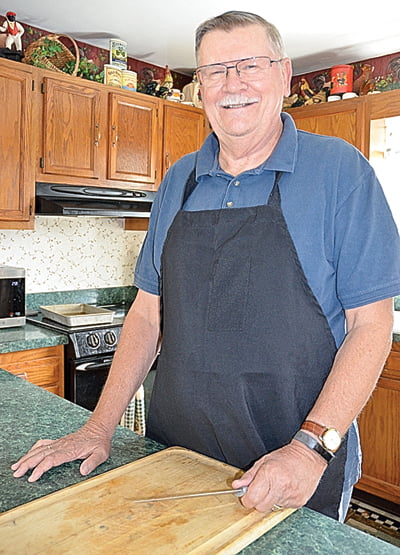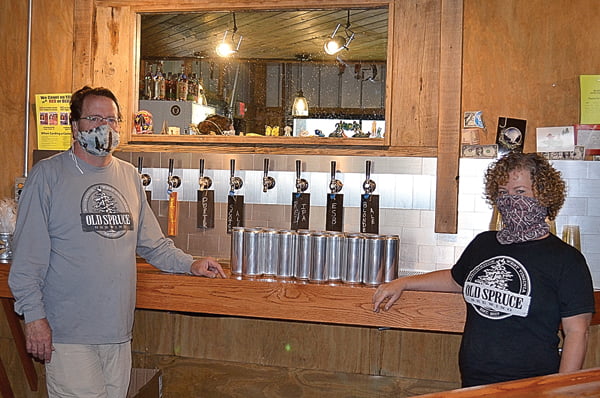
Garry McClure worked as a meat cutter for about 15 years. “I know a lot of people are considering buying beef in bulk from local sources this year,” McClure said. “And that’s a good way to get meat, especially here in Pocahontas County. With prices for meat being so high right now – whether you buy it at the store or from a local farmer – it’s really important for people to consider how best to stay within their budgets,” he said.
Laura Dean Bennett
Staff Writer
Dealing with a worldwide pandemic is a complicated process.
Even here in the relative isolation of our mountain paradise, we not only face public health risks, but must navigate changes in a regional and local economy that’s been rocked to its core.
Thank goodness energy prices and inflation are low, but in the last several months, prices for food consumed at home saw a quick jump and have continued to increase.
Meat, eggs and vegetables seem to be the most affected.
Schools and restaurants were closed, and Americans found themselves staying home and eating at home.
The increase in demand came at the same time as people were feeling the urge to stock up.
Some foods became scarcer, and prices went up.
As food is a large part of everyone’s household budget, rising prices caused many families to look for ways to save a few dollars.
And worries about food safety caused them to consider how to put safe, healthy food on the table.
Fortunately, here in “our neck of the woods,” we’re fairly well experienced in how to provide for ourselves in good times and bad.
Our parents and grandparents taught us how to be self-sufficient.
A lot of us still grow our own produce, keep chickens, raise our own meat, hunt, forage for wild foods and preserve what we can for the winter.
Many people who had gotten away from growing their own food have taken a renewed interest in doing so.
It seemed everyone was putting in a garden this year.
Seed companies and nurseries selling baby vegetable plants reported a land office business this spring.
Prices for canning jars and lids soared, and then became hard to find.
Everywhere there’s talk about people – including some who are new to it – canning and freezing their produce and buying local, pasture-raised meat.
“I’ve ordered local beef for a few years now,” said Mike Holstine, Business Manager at the Green Bank Observatory.
“We are blessed in this county to have the option of using local producers as our source of food, and we should take advantage of it.
“We know how our local folks take care of their animals and grow their produce, and it only makes sense to buy local.
“It not only helps us, but it helps keep these family farms around for the next generation.
“It’s a food source that we have to protect, and I think the rest of the world is finally seeing just how valuable it is,” Holstine added.
Those who are new to this may benefit from a few tips.
Depending on your budget and your needs, you’ll be ordering a whole, half or quarter beef.
You could go in with relatives or a small group of friends and split a whole or a half beef. A single person may not need more than a quarter, but a family will probably be able to use a half or a whole.
Always keep in mind what cuts of beef you cook most often.
If you’re buying a quarter, you may choose either a forequarter (from the neck to the second-to-last rib) or a hindquarter (everything from the second to last rib to the hind hoof).
Forequarters contain many cuts including boneless chuck roasts, boneless brisket, rib eye steaks, bone-in short ribs and ground beef.
Hindquarters contain many cuts including T-bone, Porterhouse steaks, top sirloin filet and rump roast, as well as ground beef, and, of course, stew beef from both, if you’d like.
If you want to buy in smaller volume, some farmers may consider selling what are called “primals,” for instance – brisket, chuck, rib, loin, flank or round primal.
A chuck primal contains rolled boneless neck roast, chuck eye steaks, boneless chuck roasts, Denver steaks, petite tender, ranch steaks, ground beef and soup bones.
You might want to ask around for recommendations from people who are experienced in buying local beef in bulk.
They will help point you in the right direction and offer some buying tips.
Make sure your beef will be coming from a reputable source and make sure it will be processed in a USDA-inspected facility.
When purchasing a beef, take into consideration that butchering and processing fees usually apply.
There is also a difference in cost between live weight and hanging weight.
Hanging weight is usually about 60% of the live weight of an animal.
Your beef options may include grass-fed beef (raised entirely on grass or hay); pasture raised (raised on grass but with access to grain during its last few months); or grain-fed (raised almost entirely on corn, soybeans or other grain).
You might also want to ask if antibiotics or hormones were given to the animal.

About to celebrate their 50th anniversary, Garry and Jean McClure are experts at building a beautiful life while keeping to a budget. Garry has 15 years’ experiece as a meatcutter, and Jean, who grew up on a farm, has a lifetime of experiences in baking, gardening and canning – and making ends meet.
Garry McClure, of Marlinton, knows a thing or two about meat.
He worked as a meat cutter for about 15 years – one year for A&P, two years at Pocahontas Foodland and 12 years at FasChek.
I sought him out for some advice about the most economical ways for people to buy meat.
“I know a lot of people are considering buying beef in bulk from local sources this year,” McClure said.
“And that’s a good way to get meat, especially here in Pocahontas County.
“These days, and especially since the pandemic hit, it seems a lot of people are concerned about where their meat is coming from.
“They want to know how it was raised, what it was fed, and that it’s been humanely killed – all really valid concerns.
“With prices for meat being so high right now – whether you buy it at the store or from a local farmer – it’s really important for people to consider how best to stay within their budget,” he cautioned.
“Review your options, know your budget, and know how much beef you use and what cuts of beef you use the most.
“Your family may use more hamburger than anything else, or you may like to cook a lot of roasts.
“And some families really like to eat steak,” he added.

When considering buying any meat in bulk from a local supplier, McClure stressed that the most important thing is to make sure you are buying from a reputable source.
“Ask around and get a recommendation from someone who’s done it before and maybe even visit the farm to see things for yourself,” McClure advised.
“Next, you need to know what you can spend up front so you’ll know how much meat you can buy.
“There’s live weight and hanging weight and then there’s going to be a processing fee, too.
“After you know your budget, and what the supplier is charging for a quarter, a half-or a whole beef, you’ll need to figure up exactly how much you can really use in one year, how much you can afford to buy, and how much freezer space you have,” he explained.
“Discuss the details about which cuts you’ll be getting and the price with the supplier.
“A bigger family may well be able to use a whole beef, a smaller family or a single person will need a lot less.
“The professionals will tell you to use your beef within a year; pork and chicken within six months.
Of course, if it’s vacuum sealed, it can last much longer.
“It’s a good idea to know how much beef you typically use in a year and how much room you have in your freezer to store it.
“A whole beef will probably fill an entire upright freezer; a quarter might fill two shelves in an upright freezer.
“A half would probably fill a chest freezer about halfway,” he said.
“If you want a lot of steaks and not as many roasts, I think hindquarters are the best.
“The best roasts in the beef – although there aren’t as many of them – are in the hindquarters. You’ll get three sirloin roasts and a rump roast out of it.
“On the front quarter, you get a rib roast, but “that’s about it for roasts in the front quarter.
“You used to be able to go to most any grocery and have meat – beef, pork or chicken – cut to order,” McClure recalled.
It used to be that a lot of grocery stores employed meat cutters. A housewife might well have had a favorite butcher – someone she trusted and counted on for fresh cuts of all kinds of meat.
But these days, probably due to insurance liability issues, a lot of grocery stores have stopped having meat cutters – or meat cut to order.
“Whether you buy it at the store or you buy local home raised beef, it’s not going to be inexpensive so you want to do a little research,” McClure said.
“A lot of people live paycheck to paycheck and may not be able to afford to buy in bulk – or cost may be more important to them than knowing where their meat comes from.
“That’s okay.
“There are ways to save money when you’re shopping for meat.
“Right now, meat prices are really high, so if you are buying your meat from a store, you’ll want to watch for sales,” he advised.
“But you have to really watch your prices all the time, make a note of them, so when you see a sale advertised, you can tell it’s really a good sale.
“If the wholesalers get backed up on their inventory, they’ll drop their prices and you can get some pretty good buys at your local store.
“If you only buy meat when it’s on special, you can save money,” McClure stressed.
“That goes for chicken and pork, too.”
And McClure shared a little meat-buying secret.
“The best time to buy meat is around the holidays – that’s always when the most sales are,” he said.
“There are almost always good meat specials at the holidays.
“Look for specials on hams at Easter and Christmas, turkeys at Thanksgiving and hamburger and chicken around the Fourth of July.
“For instance, I buy boneless pork loins on sale and cut them into pork chops myself.
“You’ll need a good knife and have to be careful not to cut yourself, but anybody can make simple cuts like that at home,” McClure advised.
“Now, a whole chicken is hard to cut up, but separating chicken leg quarters is easy and it can save you some money to do it yourself.
“Meat can be expensive, especially these days. You’ve just got to study the prices and decide what’s most important to you,” he concluded.
For us carnivores, it makes sense to learn a little more about where our meat comes from, how it’s raised, and how to get it in our larders without taking out a second mortgage.
Growing and raising our own food, preserving it and economizing wherever possible came naturally to us a generation or two ago.
If there’s a silver lining to the Covid-19 pandemic, it might be the fact that so many of us are taking a renewed interest in food that’s grown or raised close to home.



